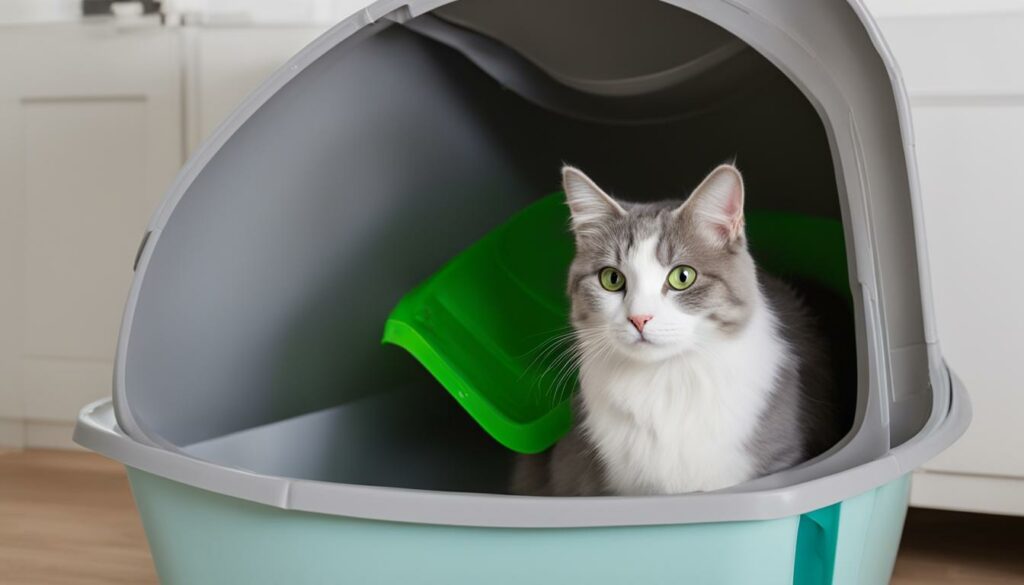Introducing a new litter box to your cat can be a challenging task. Feline behavior and litter box training play crucial roles in helping your cat make a smooth transition. To ensure success, it’s essential to understand the factors that influence your cat’s acceptance of the new litter box. From controlling variables to considering your cat’s preferences, this guide will provide you with valuable insights and tips for a successful transition.
Key Takeaways:
- Control variables such as litter type, location, and entrance/exit direction to minimize stress for your cat.
- Provide choices and incentives for your cat to use the new litter box, avoiding negative reinforcement or punishment.
- Gradually introduce a hooded or enclosed litter box, maintaining cleanliness and privacy.
- Consider your cat’s preferences when selecting a new litter box style, such as the height of the entrance/exit.
- Consult with a veterinarian if your cat consistently refuses to use the new litter box, as it may indicate underlying health issues.
Reasons For Switching To A New Style of Litter Box
Switching to a new style of litter box can help address common litter box problems, improve cat hygiene, and streamline litter box maintenance. There are several reasons why cat owners may choose to make this change. One common reason is the accumulation of odor in the old litter box, which can be unpleasant for both cats and their owners. By switching to a new litter box style, such as one with better odor control features, you can create a more pleasant and hygienic environment for your cat.
Another reason for switching to a new litter box style is aesthetic preferences. Some cat owners may find that their current litter box does not fit well with their home decor, and they want to find a more visually appealing option. By selecting a litter box that matches your style and preferences, you can ensure that your cat’s bathroom area blends seamlessly with the rest of your home.
Finally, a new litter box style can also make litter box maintenance easier. Some litter boxes come with built-in features that simplify the cleaning process, such as self-cleaning mechanisms or liners that make it easier to dispose of soiled litter. By choosing a litter box that meets your needs and preferences in terms of maintenance, you can save time and effort in keeping your cat’s litter box clean and fresh.
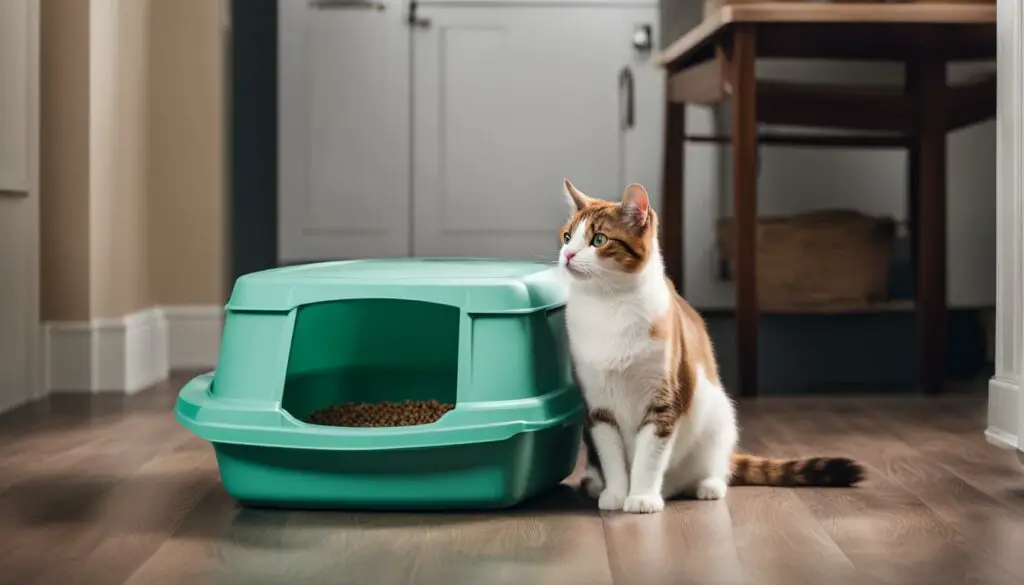
Table: Pros and Cons of Switching to a New Style of Litter Box
| Pros | Cons |
|---|---|
| Improved odor control | Resistance to change from the cat |
| Enhanced aesthetic appeal | Cost of purchasing a new litter box |
| Easier maintenance | Adjustment period for the cat |
It’s important to note that cats may resist the change to a new litter box style due to stress and unfamiliarity. To help ease their transition, it’s recommended to introduce the new litter box gradually and provide positive reinforcement. By addressing their concerns and familiarizing them with the new litter box, you can minimize any potential litter box problems and ensure a smooth transition.
Overall, switching to a new style of litter box can be a beneficial decision for both cat owners and their feline companions. It can help address common litter box problems, improve cat hygiene, and simplify litter box maintenance. However, it’s important to consider your cat’s preferences and ensure a gradual transition for a successful switch to the new litter box style.
Controlling Variables for Successful Litter Box Training
When introducing a new litter box to your cat, it’s important to control variables and keep other factors constant. By maintaining consistency in key elements such as litter type, location, and entrance/exit direction, you can help your cat adjust to the change more easily.
Litter Type: Choose the same type of litter that your cat is accustomed to. Cats have preferences for certain textures and scents, so switching to a completely different litter may cause reluctance. Gradually transitioning to a new litter type can also help with the adjustment process.
Location: Keep the new litter box in the same area as the old one. Cats are creatures of habit, and changing the location of their litter box can be confusing and stressful. If the old location is not suitable, gradually move the litter box to a new location over time.
Entrance/Exit Direction: Face the entrance/exit of the new litter box in the same direction as the old one. Cats rely on familiar cues to navigate their surroundings, and keeping the same orientation can help them associate the new litter box with their usual bathroom behavior.
By controlling these variables, you can minimize stress and confusion for your cat, and increase the likelihood of successful litter box training.
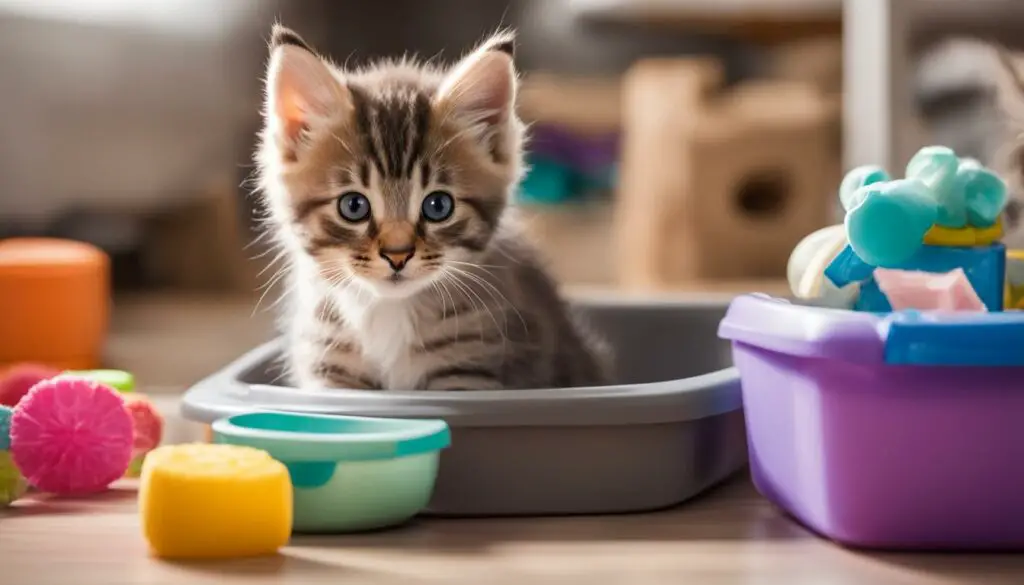
Table: Key Elements for Controlling Variables in Litter Box Training
| Litter Box Variable | Importance | Tips |
|---|---|---|
| Litter Type | Crucial | Choose the same type of litter or transition gradually |
| Location | Essential | Keep the litter box in the same area as the old one or transition gradually |
| Entrance/Exit Direction | Important | Face the entrance/exit in the same direction as the old litter box |
“Maintaining consistency in litter box training is key to helping your cat adjust to the change. By controlling variables such as litter type, location, and entrance/exit direction, you can create a familiar environment for your cat, increasing the likelihood of successful litter box training.” – Cat Behavior Expert
Transitioning from Unhooded to Hooded/Enclosed Litter Box
When it comes to litter box style, transitioning from an unhooded to a hooded or enclosed litter box can have its benefits. Not only can it help with odor control and cleanliness, but it can also provide your cat with the privacy they may prefer. Contrary to popular belief, many cats are not bothered by the style of the litter box as long as it is kept clean and provides a comfortable environment.
To successfully transition your cat to a hooded or enclosed litter box, it’s important to take gradual steps. Start by presenting the new litter box without the hood or top, allowing your cat to get comfortable with the new style. Once they are familiar with the tray itself, gradually introduce the hood or top. This gradual approach can help your cat feel more at ease and prevent any resistance to the change.
It’s crucial to maintain cleanliness when using a hooded or enclosed litter box. Regularly scoop the litter and clean the box to prevent any odors or discomfort for your cat. Make sure the litter is at an appropriate depth and provide enough litter for your cat to dig and cover their waste. By keeping the litter box clean and inviting, your cat is more likely to accept and use the new style without any hesitation.
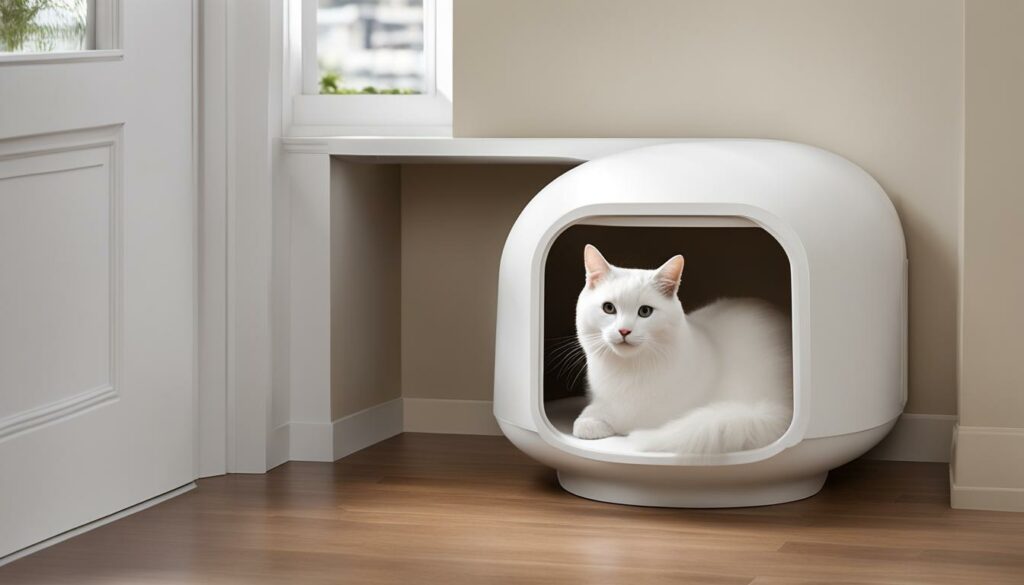
Transitioning from Unhooded to Hooded/Enclosed Litter Box
Transitioning from an unhooded litter box to a hooded or enclosed style can be a smooth process with patience and proper introduction. By gradually acclimating your cat to the new litter box, ensuring cleanliness, and providing privacy, you can create a comfortable environment that promotes successful litter box usage.
| Transition Steps | Tips for Success |
|---|---|
| Start by presenting the new litter box without the hood or top | Allow your cat to explore and get comfortable with the new style |
| Gradually introduce the hood or top | Give your cat time to adjust to the added enclosure |
| Maintain cleanliness | Regularly scoop the litter and clean the box to avoid odors |
| Provide privacy | Ensure the litter box is placed in a quiet, secluded area |
By following these steps and considering your cat’s preferences, transitioning from an unhooded to a hooded or enclosed litter box can be a positive experience for both you and your feline friend.
Thinking Outside the Box for Successful Transition
When it comes to litter box training, sometimes we encounter challenges along the way. If your cat is not adapting to the new litter box despite controlling variables and following proper techniques, it’s time to think outside the box and explore alternative solutions. Here are some tips to help you navigate through common litter box training problems and find success:
1. Placement and Appeal
Consider placing the new litter box in the same location as the old one. Cats are creatures of habit, and familiarity can help increase their comfort level. Additionally, make the new litter box more appealing by adding a different type of litter or experimenting with different textures. Some cats may prefer finer granules, while others may prefer coarser ones. Providing options can encourage your cat to use the new litter box.
2. Positive Reinforcement
Positive reinforcement plays a crucial role in encouraging desired behaviors. When your cat uses the new litter box, reward them with praise, treats, or playtime. This will help them associate the new litter box with positive experiences and increase their willingness to use it. Conversely, avoiding negative reinforcement or punishment is essential, as it may create anxiety or aversion towards the litter box.
3. Consult with a Professional
If you’ve tried various techniques and your cat continues to resist the new litter box, it may be beneficial to consult with a professional, such as a veterinarian or animal behaviorist. They can provide personalized advice and guidance based on your cat’s specific needs and help you navigate any obstacles you may be facing during the transition process.

| Common Litter Box Training Problems | Solutions |
|---|---|
| Refusing to use the new litter box | – Place the new litter box in the same location as the old one\n- Make the new litter box more appealing by trying different types of litter\n- Provide choices and incentives for your cat |
| Consistently having accidents outside the litter box | – Ensure the litter box is clean and accessible\n- Increase the number of litter boxes in your home\n- Address any underlying health issues |
| Showing signs of anxiety or stress during litter box training | – Create a calm and quiet environment for the litter box\n- Use pheromone diffusers to promote relaxation\n- Consider using natural remedies or consulting with a veterinarian |
Remember, every cat is unique, and what works for one may not work for another. Be patient and persistent in finding the right solution for your cat’s litter box training needs. With time, patience, and a little bit of creativity, you can help your cat successfully transition to the new litter box.
Understanding the Cat’s Preference and Comfort
When it comes to litter box training, understanding your cat’s preferences and comfort is key to ensuring a successful transition. Cats can be quite particular about their litter box habits, and making the right choices can make all the difference in their willingness to use it. Let’s explore some factors to consider when selecting a litter box for your feline friend.
Size and Height:
Cats come in different shapes and sizes, so it’s important to choose a litter box that accommodates their needs. A larger cat may prefer a bigger litter box that gives them more space to move around, while a smaller cat may feel overwhelmed in a large litter box. Additionally, consider the height of the litter box’s entrance/exit. Senior cats or cats with mobility issues may find it easier to use a litter box with a lower entrance/exit.
Material and Texture:
Cats often have specific preferences when it comes to the material and texture of their litter box. Some cats may prefer a smooth plastic surface, while others may prefer a textured surface that provides better traction for scratching. Experimenting with different materials can help you find the one that your cat finds most comfortable and inviting.
Location:
The location of the litter box can also impact your cat’s willingness to use it. Cats generally prefer privacy when using the litter box, so placing it in a quiet and secluded area can help create a sense of security. Avoid placing it in high-traffic areas or near noisy appliances that may startle your cat.
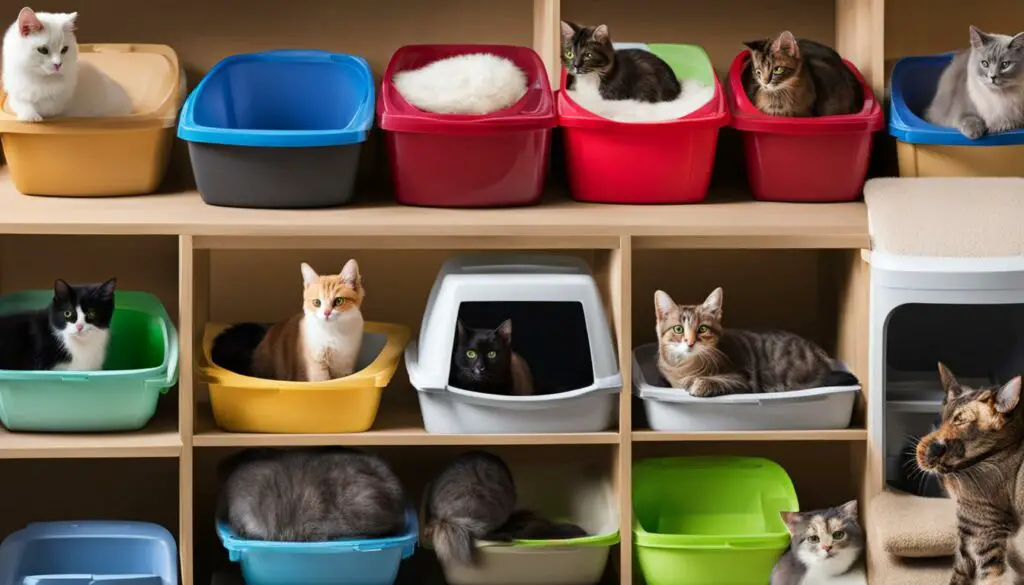
| Litter Box Preference | Description |
|---|---|
| Open Top Litter Box | This traditional style provides easy access and allows for better ventilation. It’s suitable for cats who prefer more space and don’t mind the lack of privacy. |
| Top-Entry Litter Box | This style features a lid with a small opening on top. It provides both privacy and odor containment, making it a popular choice for cats who prefer seclusion. |
| Corner Litter Box | Designed to fit into corners, these litter boxes save space and offer a cozy and secure environment. Cats who prefer a quieter and more confined space may appreciate this style. |
| Self-Cleaning Litter Box | These automated litter boxes remove waste automatically, providing a clean and odor-free environment. Some cats may be hesitant at first, but with proper introduction and training, they can adapt to this convenient option. |
Remember, cats are unique individuals with their own preferences. It may take some trial and error to find the litter box that suits your cat’s needs. By considering factors such as size, height, material, texture, and location, you can increase the chances of a successful transition and create a comfortable and inviting environment for your furry friend.
Identifying Potential Health Issues
When your cat consistently refuses to use the new litter box, it’s crucial to consider the possibility of underlying health issues. Cats may experience urinary tract infections or digestive illnesses that can cause aversion to the litter box. If the behavior persists despite following proper training techniques, it’s best to consult with a veterinarian to rule out any medical concerns.
Cat health is a vital aspect of their overall well-being and can significantly impact their litter box habits. By identifying potential health issues early on, you can ensure timely intervention and appropriate treatment. Some common signs of health problems in cats include frequent urination, blood in the urine, changes in appetite or weight, lethargy, and vomiting. If your cat exhibits any of these symptoms or shows consistent aversion to the new litter box, a veterinary visit is warranted.
A veterinarian can perform a thorough examination, conduct necessary tests, and provide a diagnosis. Treatment options may include medication, dietary changes, or specialized care to address the underlying health issue. Resolving any health problems will not only improve your cat’s litter box habits but also contribute to their overall quality of life.
Common Cat Health Concerns
Here are some common health concerns that can affect a cat’s litter box behavior:
- Urinary tract infections
- Bladder stones
- Internal parasites
- Gastrointestinal issues
- Arthritis or joint pain
By being proactive and attentive to your cat’s health, you can ensure that any potential issues are promptly addressed, leading to improved litter box usage and a happier, healthier feline companion.
| Signs of Potential Health Issues: | Common Health Concerns: |
|---|---|
| Frequent urination | Urinary tract infections |
| Blood in the urine | Bladder stones |
| Changes in appetite or weight | Internal parasites |
| Lethargy | Gastrointestinal issues |
| Vomiting | Arthritis or joint pain |
Remember, if your cat consistently avoids the new litter box, it’s essential to consult with a veterinarian to rule out any potential health concerns. Taking proactive steps to address your cat’s health will help resolve their litter box aversion and ensure a happy and comfortable feline companion.
Preparing for Your New Cat
Before bringing your new cat home, it’s important to make sure you have all the essential supplies to provide a comfortable and engaging environment for your feline friend. Here is a list of cat essentials that you should have:
- Litter box
- Cat litter
- Litter scoop
- Litter liners
- Play toys
- Quality food
- Food and water dishes
- Scratching post
- Natural cleaners
- Cat brush
Having a litter box is crucial for your cat’s hygiene. Choose a litter box that suits your cat’s needs and preferences. Consider factors like size, accessibility, and ease of cleaning. Provide an adequate amount of cat litter and place the litter box in a quiet and accessible area.
Play toys are essential to keep your cat entertained and mentally stimulated. Choose a variety of interactive toys to keep them engaged, such as feather wands, laser pointers, or treat-dispensing toys. Regular playtime also helps strengthen the bond between you and your new cat.
Ensure you have quality food and water dishes that are easy to clean and suitable for your cat’s size. Choose a balanced and nutritious cat food that meets their dietary needs. Consult with a veterinarian to determine the right type and portion size for your cat.
| Essentials | Description |
|---|---|
| Litter box | A suitable litter box that provides comfort and privacy. |
| Cat litter | A high-quality litter that controls odor and clumps well. |
| Litter scoop | A tool to clean the litter box and remove waste. |
| Litter liners | Optional liners to make cleaning the litter box easier. |
| Play toys | A variety of toys to keep your cat entertained and active. |
| Quality food | Nutritious cat food that meets your cat’s dietary needs. |
| Food and water dishes | Durable and easily cleaned dishes for feeding and watering. |
| Scratching post | A designated area for your cat to scratch and stretch. |
| Natural cleaners | Safe and effective cleaning products for accidents or messes. |
| Cat brush | A grooming tool to keep your cat’s coat clean and healthy. |
By being prepared and having these cat essentials, you can ensure a smooth transition for your new cat and provide a welcoming and comfortable home for them to thrive in.
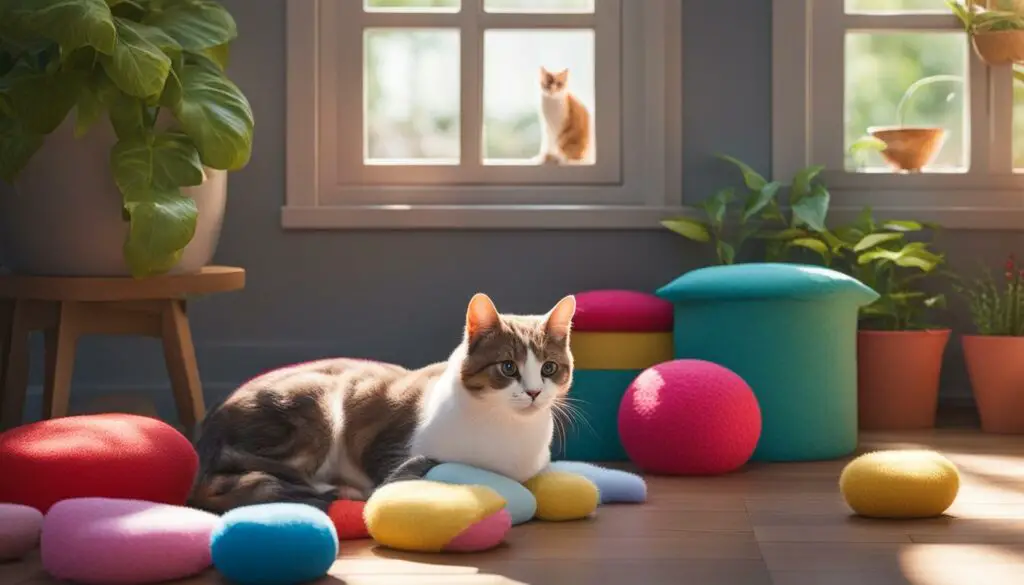
Setting Up A Safe Space
When bringing a new cat into your home, it’s important to provide them with a safe and comfortable living environment. Creating a dedicated space for your cat can help them feel secure during the initial transition period. This space should include their litter box, feeding station, and a safe hideaway where they can retreat to when they need some quiet time.
In cat-proofing the house, it’s crucial to remove potential hazards and ensure the safety of your furry friend. This includes keeping toxic plants, cleaning products, and small objects out of their reach. It’s also important to secure any loose cords or wires that could pose a choking hazard.
To further enhance the environment, consider providing vertical spaces such as cat trees or shelves where your cat can climb and explore. This will help satisfy their natural instinct to climb and perch. Providing scratching posts and interactive toys will also keep them mentally stimulated and prevent destructive behavior.
Creating a Safe Space for Your Cat
Here’s a checklist to help you set up a safe space for your new cat:
- Designate a quiet area: Choose a low-traffic area of your home where your cat can have some privacy.
- Set up a litter box: Place a clean litter box in a quiet corner of the space, away from their feeding area.
- Create a feeding station: Provide food and water bowls in a separate area, preferably away from the litter box.
- Provide a safe hideaway: A cozy cat bed, a cardboard box with a soft blanket, or a hiding tunnel can serve as a safe retreat for your cat.
- Remove potential hazards: Make sure there are no small objects, toxic plants, or household chemicals within reach of your cat.
- Secure loose cords and wires: Use cord covers or hide them behind furniture to prevent your cat from chewing on them.
- Offer vertical spaces: Install cat trees, shelves, or window perches to provide climbing and perching opportunities.
- Provide scratching posts and toys: Encourage healthy scratching and mental stimulation with appropriate toys and scratching surfaces.

By setting up a safe space for your new cat, you can help them adjust to their new surroundings and ensure their well-being. Remember to give them plenty of love, patience, and positive reinforcement as they explore their new home.
Creating a Cat-Friendly Home Environment
When bringing a new cat into your home, it’s important to create a safe and welcoming environment that is conducive to their natural instincts and behaviors. By making your house cat-friendly, you can ensure their comfort, happiness, and overall well-being. Here are some tips to help you create a cat-friendly home:
1. Minimize Household Dangers
Cats are curious creatures, and it’s important to remove any potential hazards that could harm them. Keep all toxic substances, such as cleaning products and medications, securely stored and out of reach. Ensure that windows and balconies are properly secured to prevent falls, and be cautious with electrical cords to prevent chewing. It’s also a good idea to avoid using plants that are toxic to cats or keep them out of reach.
2. Provide Vertical Space
Cats love to climb and perch on high surfaces, as it gives them a sense of security and allows them to observe their surroundings. Provide vertical spaces such as cat trees, shelves, or window perches where your cat can climb and rest comfortably. This will not only fulfill their natural instincts but also help prevent boredom and encourage exercise.
3. Create Cozy Hideaways
Cats appreciate having safe and quiet spaces where they can retreat and relax. Set up cozy hideaways such as cat beds, igloos, or covered resting spots where your cat can retreat when they need some alone time. These hideaways should be placed in quiet areas of the house, away from high traffic or noisy areas.

4. Provide Interactive Toys and Enrichment
Keep your cat mentally and physically stimulated by providing them with a variety of interactive toys and enrichment activities. This can include puzzle toys, treat-dispensing toys, and interactive play sessions with wand toys or laser pointers. Regular playtime not only helps prevent boredom but also strengthens the bond between you and your cat.
5. Establish a Litter Box Area
Designate a specific area in your home for the litter box. Cats prefer privacy when using the litter box, so choose a quiet and low-traffic area where they can do their business undisturbed. Ensure that the litter box is easily accessible and kept clean at all times to encourage proper litter box habits.
6. Avoid Stressful Situations
Cats are sensitive to changes in their environment and may become stressed in certain situations. Avoid loud noises, excessive handling, or overcrowded spaces that can cause anxiety for your cat. Provide them with a calm and peaceful environment where they feel safe and comfortable.
By following these tips, you can create a cat-friendly home that provides your feline companion with a happy and enriching environment. Remember, each cat is unique, so be sure to observe their preferences and make adjustments accordingly.
Maintaining Litter Box Cleanliness and Training
Keeping the litter box clean is essential for your cat’s health and well-being. Regular cleaning not only helps prevent odor and hygiene issues but also encourages your cat to continue using the litter box. Here are some tips for maintaining litter box cleanliness and effective litter box training:
1. Scoop the litter box daily:
Remove waste from the litter box at least once a day. This helps prevent odor buildup and provides a clean environment for your cat. Invest in a good quality litter scoop that allows you to easily remove clumps and waste without disturbing the clean litter.
2. Change the litter regularly:
While scooping the litter daily is important, it’s also essential to completely change the litter on a weekly basis. Empty the litter box, wash it with mild soap and water, and refill it with fresh litter. This not only eliminates any lingering odor but also provides a fresh and inviting space for your cat.
3. Use an appropriate litter:
Choose a litter that suits both your cat’s preferences and your cleaning routine. There are various types of litter available, including clumping, non-clumping, scented, and unscented. Experiment with different options to find the one that works best for you and your cat. Remember, some cats may have sensitivities or allergies to certain litter types, so be mindful of their comfort.
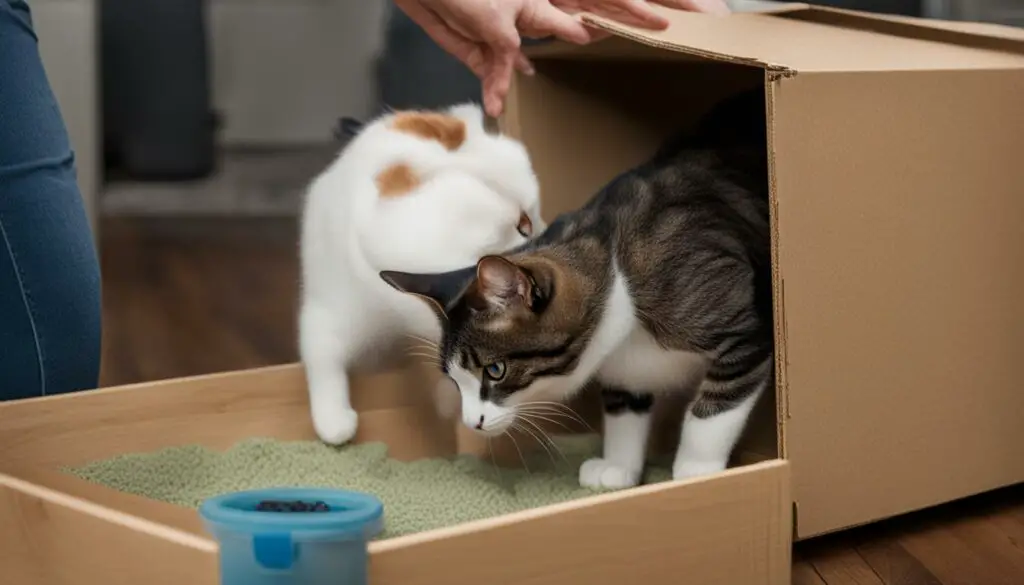
4. Provide multiple litter boxes:
If you have multiple cats, it’s important to provide separate litter boxes for each of them. Cats prefer to have their own designated space for elimination, and having multiple litter boxes can help prevent territorial issues and provide easier access to a clean litter box.
5. Positive reinforcement:
When your cat uses the litter box appropriately, provide positive reinforcement such as praise, treats, or playtime. This helps reinforce the behavior and encourages your cat to continue using the litter box consistently.
6. Seek veterinary advice for litter box issues:
If your cat consistently avoids using the litter box or displays any unusual behavior, it’s important to consult with a veterinarian. There may be underlying health issues causing the aversion, and a professional can provide guidance and solutions to overcome the problem.
By following these tips, you can maintain a clean litter box and ensure successful litter box training for your cat. Remember, patience and consistency are key when it comes to litter box training, so don’t get discouraged if it takes some time for your cat to adjust. With proper care and attention, your cat will become comfortable and confident in using their litter box.
Building a Relationship with Your Veterinarian
When it comes to caring for your cat, establishing a strong relationship with a trustworthy veterinarian is crucial. Regular vet check-ups, vaccinations, and access to professional guidance are essential for your cat’s overall health and well-being. Finding a cat-friendly vet in your area is the first step towards building that relationship. Look for a vet who specializes in feline medicine and understands the unique needs and behaviors of cats.
During your visits to the vet, take the time to communicate openly and honestly about your cat’s health and any concerns you may have. This will help your vet make accurate diagnoses and provide appropriate treatment. Be prepared to provide a detailed medical history of your cat, including any previous illnesses, surgeries, or vaccinations.
Remember, veterinary care is not just limited to when your cat is sick or injured. Regular preventive care, such as dental cleanings and parasite control, is equally important. Your vet will guide you on the appropriate schedule for vaccinations, deworming, and flea and tick prevention based on your cat’s age and lifestyle.
“Regular vet check-ups, vaccinations, and access to professional guidance are essential for your cat’s overall health and well-being.”
The Benefits of a Cat-Friendly Vet
Choosing a cat-friendly vet ensures that your cat will have a positive experience during visits. Cat-friendly practices often have separate waiting areas for cats and dogs, minimizing stress and anxiety for your feline friend. They may also use feline pheromones or calming techniques to create a soothing environment.
A cat-friendly vet will have staff trained in handling cats gently and with care. They will take the time to understand your cat’s individual temperament and adjust their approach accordingly. This helps reduce fear and stress during examinations and procedures.
Building Trust and Comfort
To build a strong relationship with your vet, it’s important to prioritize trust and open communication. Take the time to ask questions and seek clarification on any concerns you may have. A good vet will take the time to listen to you and provide detailed explanations in a way that you can understand.
Additionally, it’s beneficial to schedule regular wellness exams for your cat, even if they appear healthy. These exams allow your vet to detect any potential health issues early on and address them before they become more serious. Regular visits also give your cat an opportunity to become familiar with the vet’s office and build a positive association with the experience.
Remember, your vet is a valuable resource for all aspects of your cat’s health and well-being. By building a strong relationship, you can ensure that your cat receives the best possible care throughout their life.

The Importance of Playtime
Playtime is a crucial aspect of a cat’s daily routine, providing mental stimulation, exercise, and an opportunity for bonding. Engaging in interactive play sessions with your cat helps satisfy their natural instincts, prevents boredom, and promotes overall well-being. Interactive toys are a fantastic way to keep your cat entertained and mentally engaged. They provide an outlet for their energy and help prevent obesity-related illnesses.
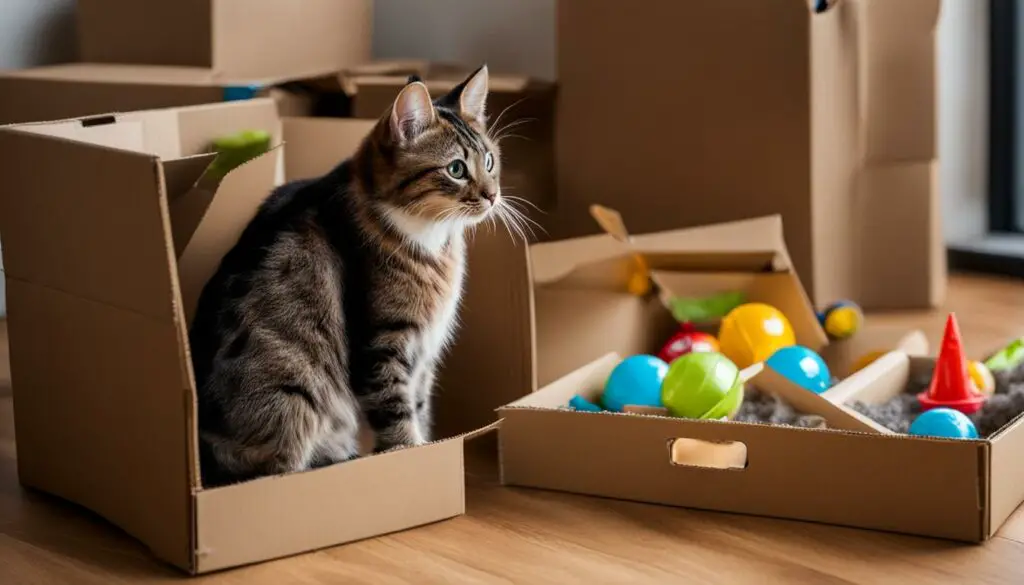
Interactive toys come in various shapes and sizes, from glittery balls to feathery boas to catnip-filled mice. These toys mimic the movements of prey, triggering your cat’s hunting instincts. Additionally, they provide sensory stimulation through textures, sounds, and scents. By rotating the toys regularly, you can keep the play sessions fresh and exciting for your feline companion.
Playtime also offers an opportunity for you to bond with your cat. Use a wand toy or interactive puzzle toy to engage in interactive play and strengthen your relationship. It’s important to remember that cats have different play preferences, so try different toys and techniques to see what works best for your cat.
Tips for Adopting a Kitten
Bringing a new kitten into your home is an exciting and joyful experience. However, it’s important to ensure that your home is safe and kitten-proofed to protect your furry friend from potential hazards. Here are some essential tips for adopting a kitten and creating a safe environment:
Kitten-Proofing the House
Before your kitten arrives, it’s crucial to make your home safe and kitten-proof. Start by removing any toxic plants, chemicals, or household items that could be harmful if ingested. Secure loose cords and wires, cover electrical outlets, and ensure that window screens are secure. Keep small objects and choking hazards out of reach, and block off any dangerous areas or tight spaces where your kitten could get stuck.
Create a Comfortable Space
Set up a dedicated space for your kitten that includes a cozy bed or blanket, fresh water, and a litter box. Provide a scratching post and a variety of toys to keep your kitten entertained and engaged. This will help your kitten feel secure and help them adjust to their new surroundings.
Establish a Routine
Kittens thrive on routine, so establish a consistent feeding schedule and playtime routine. This will help your kitten feel safe and secure, and it will also aid in their potty training. Spend quality time bonding with your kitten through play and gentle affection, and ensure they have plenty of opportunities to explore and exercise.
| Tips for Adopting a Kitten | Kitten-Proofing the House | Create a Comfortable Space | Establish a Routine |
|---|---|---|---|
| Remove toxic plants, chemicals, and hazards | Set up a cozy bed, fresh water, and a litter box | Provide a scratching post and toys for entertainment | Establish a consistent feeding and playtime routine |
| Secure loose cords and cover electrical outlets | Ensure the space is safe and kitten-friendly | Create a secure and comfortable environment | Help your kitten feel safe and secure |
| Keep small objects and choking hazards out of reach | Encourage exploration and exercise | Aid in potty training and bonding |
By following these tips and providing a safe and loving environment, you can ensure a smooth transition for your new kitten and lay the foundation for a happy and healthy life together.
Conclusion
Bringing a new cat into your home is an exciting and rewarding experience. This ultimate guide has provided valuable insights and tips for successfully introducing a new litter box and ensuring your cat’s comfort and satisfaction. By understanding their preferences, addressing potential health issues, and creating a cat-friendly environment, you can establish a strong bond and enjoy a long, happy life together.
As a responsible cat owner, prioritize their needs and provide positive reinforcement during the transition. Remember to maintain litter box cleanliness, offer engaging playtime sessions, and establish a trusting relationship with a cat-friendly veterinarian. This will ensure that your furry friend receives the best care and attention.
By following the advice in this guide, you’ll be well-prepared to provide your new cat with a safe and loving home. Enjoy the journey of cat ownership, and may it be filled with joy, companionship, and countless precious moments.
FAQ
What can I do if my cat won’t use the new litter box?
Start by controlling variables, such as using the same type of litter and keeping the location consistent. Gradually introduce the new litter box and provide choices and incentives for your cat. Avoid negative reinforcement or punishment.
Why should I switch to a new style of litter box?
There are several reasons, including odor accumulation, aesthetic preferences, and better cleanliness. However, cats may resist the change due to stress and unfamiliarity.
How can I control variables when introducing a new litter box?
Keep factors such as litter type, location, and entrance/exit direction consistent. This helps minimize stress and confusion for your cat and allows them to associate the new litter box with their usual bathroom behavior.
How can I transition from an unhooded to a hooded/enclosed litter box?
Gradually introduce the hood or top by initially presenting the cat with only the litter tray. Make sure to maintain cleanliness and provide privacy to help your cat adjust.
What should I do if my cat still refuses to use the new litter box?
Place the new litter box where the old one was, make it more appealing, upgrade the litter, clean it regularly, and offer positive reinforcement. Providing options and positive experiences will encourage your cat to use the new litter box.
How do I choose the right litter box style for my cat?
Consider factors such as the height of the entrance/exit and your cat’s preferences. Senior cats may require a lower entrance/exit, while kittens may benefit from a shallower litter tray.
What if my cat consistently refuses to use the new litter box?
It’s important to consider the possibility of underlying health issues. Cats may have urinary tract infections or digestive illnesses that can cause aversion to the litter box. Consult with a veterinarian if the behavior persists.
What supplies do I need before bringing a new cat home?
You will need a litter box, cat litter, litter scoop, litter liners, play toys, quality food, food and water dishes, a scratching post, natural cleaners, and a cat brush.
How can I create a safe and comfortable space for my new cat?
Set up a separate living area with a litter box, feeding station, and a safe hideaway. Eliminate potential hazards and provide entertainment and stimulation.
How can I make my house cat-friendly?
Avoid harsh chemical cleansers, keep potentially dangerous items out of reach, and secure valuable items. Ensure the safety of other pets and remove household hazards.
How often should I clean the litter box?
It’s important to clean the litter box daily by scooping and change the litter weekly to prevent odor accumulation. Choose a suitable litter and follow proper training techniques for a positive litter box experience.
How important is it to have a relationship with a veterinarian?
Establishing a long and trusting relationship with a veterinarian is crucial for your cat’s overall health and well-being. Regular check-ups, vaccinations, and access to professional advice are important aspects of responsible pet ownership.
Why is playtime important for cats?
Playtime provides mental stimulation, exercise, and bonding opportunities. Interactive toys can keep your cat engaged and prevent obesity-related illnesses.
What should I consider when adopting a kitten?
Prepare a safe and kitten-proof environment, provide kitten-friendly toys, and schedule regular veterinary check-ups. Be aware of their tendency to explore small spaces and potential dangers.

